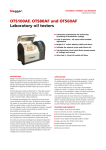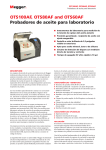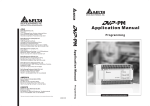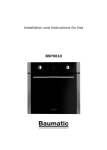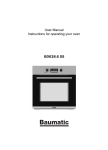Download Manual
Transcript
M OTS60SX Semi Automatic Oil Test Set User Manual 99 Washington Street Melrose, MA 02176 Phone 781-665-1400 Toll Free 1-800-517-8431 Visit us at www.TestEquipmentDepot.com Contents Guide de l’utilisateur - p14 Gebrauchsanleitung - s24 Safety Warnings 3 Preparing the Oil Test Set 5 General Description Operation Oil Sampling Preparing the Oil Test Vessel Control Panel Breakdown Testing Withstand Testing Warning messages Testing to National Standards Sampling and Testing Oil for Dielectric strength 4 5 5 5 6 6 6 7 7 8 Oil Testing Specifications 10 Accessories 12 Test Set Specification Repair and Warranty 2. 10 13 Guía del usuario - p34 SAFETY WARNINGS • • • • • • • Safety warnings and precautions must be read and understood before the instrument is used. They must be observed during use. The oil test set must be properly earthed. The test chamber must be kept scrupulously clean. If the test chamber cover is cracked or damaged in any way the test set must not be used, but sent for repair to an authorised agent. The chamber door hinges are fitted with earth contact springs. These must not be damaged or corroded. The correct type of oil test vessel must be used, and correctly positioned on the support horns before carrying out any testing. Replacement fuses must be of the correct type and rating. NOTE THE TEST SET MUST ONLY BE USED BY SUITABLY TRAINED AND COMPETENT PERSONS. Symbols used on the Test Set Caution: Refer to accompanying notes. Risk of electric shock. Equipment complies with relevant EU Directives 3. General Description The OTS60SX is a lightweight, semi-automatic, oil dielectric strength test set. The instrument is suitable for protected field use and can be powered from a range of mains supplies. The maximum 60 kV output allows tests to be performed on oil from a wide variety of electrical installations including transformers, circuit breakers and other equipment. The operation of the test set is extremely simple and the results are displayed on a bright LED display. A selection of vessels enables the instrument to be configured for a variety of tests. Voltage Selector The semi automatic operation allows all types of testing to be performed. An automatic one minute timer operates when the high voltage is paused for Withstand (proof) testing. Oil samples can also be tested according to breakdown specification by using a suitable sequence of tests. The instrument is constructed in a strong, sheet steel case. Handles are provided for ease of transportation. A pouch is located on the side of the instrument to contain accessories such as the power cord, additional electrodes and the spacing gauge. An optional carrying case incorporates a shoulder strap. Fuseholders Mains power input A number of vessels are available suitable for testing to a wide range of national specifications. Three types of electrode are available; spherical (IEC type), mushroom (VDE/ASTM D1816) and cylindrical (ASTM D877). The oil sample can be stirred by a motor driven impeller available in selected vessels. The vessel is located in the top of the instrument and covered by a transparent polycarbonate door with a mesh screen so that the oil breakdown can be viewed. A safety interlock ensures that the high voltage is disconnected when the chamber door is opened. Mains Input Panel 4. Preparing the Oil Test Set Ensure that the instrument is properly earthed. The test set must be connected to a socket (receptacle) with a protective earth (ground) conductor. Before connecting the instrument to the mains power supply, ensure the voltage selector located on the mains input panel is set to the required voltage. The correct fuse value should be fitted for the supply voltage (See Specification). The fuse holders are located next to the supply inlet. Power cord If the power cord plug is not suitable for your type of socket outlets, do not use an adaptor. You should use a suitable alternative power cord, or if necessary change the plug by cutting the cord and fitting a suitable plug. The colour code of the cord is: Earth (Ground) Yellow / Green Phase (Line) Brown Neutral Blue If using a fused plug, a 3 Amp fuse to BS 1362 should be fitted. Note: A plug severed from the power cord should be destroyed, as a plug with bare conductors is hazardous in a live socket outlet. Operation Oil Sampling The relevant test specification will give advice on the best methods to use when sampling oil. Contamination of the oil may lead to misleading results. Always run off a small amount of oil before sampling and ensure that the flow of oil is steady. Preparing the Oil Test Vessel Optional vessels are available for testing to national specifications (See table and Accessories). Some specifications require stirring of the oil sample as well as different test electrode shapes. Once the correct vessel has been chosen for the required test the electrode gap should be set. This is achieved by adjusting the threaded nut on the side of the vessel. Small adjustment of the gap can be made by hand tightening the nuts and rotating the spindle. A slot is provided on the end of the spindle for this purpose. A set of individual 0,5mm feeler gauges is provided for accurate measurement of the gap. Gauges can be combined to measure from 1mm to 4mm. (see page 12) Clean the vessel in accordance with the instructions given in the relevant test specification. Allowing space for the lid to be fitted, fill the vessel with the oil sample. The amount of oil required will depend upon the type of lid used. Load the vessel in the test chamber, connecting the motor power cable, if fitted, and carefully shut the door so that the safety interlock switch operates. 5 LED Display Control Panel The control panel contains the supply on/off switch, the high voltage display, voltage ramp rate selection and the three control keys. The operation of the instrument is very simple. When the instrument is turned on, the on/off switch is illuminated, and the software edition code will be flashed up on the display. s Breakdown Testing The suitable ramp rate for the test to be performed should be selected using the ‘s' key. The START key ‘ ‘ will then turn on the high voltage. The red H.V. indicator will light to show the output voltage is on. The voltage will then increase at the selected ramp rate and the corresponding value will be shown on the display. If oil breakdown occurs the instrument will detect this and immediately shut off the high voltage. The breakdown voltage value will be left on the display until the next test is started. If no breakdown occurs, the high voltage will rise to 60 kV. At this point the test voltage is cut off and this maximum value left on the display. Main controls Ramp rate selection Mains on/off switch HV on indicator Control Panel 6. A test can be stopped at any time by pressing the STOP ‘n’ button. This will remove the high voltage from the oil sample and leave the display at 0,0 kV. Withstand Testing A Withstand (proof) test can be carried out by pressing the PAUSE ‘ ‘ key. This will maintain the high voltage at the current value for one minute. After this time the high voltage will continue to rise until one of the following:1) Oil breakdown occurs 2) The STOP ‘n' key is pressed 3) The output voltage reaches the maximum value of the test set. During withstand testing the ramp rate can be changed while the pause is in progress. This can allow the withstand test value to be accurately set by adjusting the ramp rate to the lowest value. Warning Messages Door Open If the instrument overheats, the words ‘ ‘ and ‘ will be alternately displayed and the ‘ operation disabled. This will reset automatically, when cooled, after a few minutes. Testing to National Standards The OTS60SX can be used to test to any international standard. A table of the standards is given on page 10. To perform these tests it is necessary to select the correct vessel so that the specified electrodes and suitable stirring are used. Most standards require repetitive breakdown tests to be carried out and the average taken. Note that sometimes the first breakdown result is omitted from the average calculation. If continuous stirring is not required the stirrer motor supply can be disconnected when appropriate by opening the chamber door. 100 ml Oil Test Vessel The D877 Low Volume Test Vessel is an optional accessory for use with the Megger® OTS60SX Oil Test Set. The test vessel must be kept scrupulously clean. Before each use, dismantle the test vessel, clean and dry, re-assemble, and set the electrode gap to 2,54 mm (0.100 inch). Dismantling the vessel 1. Loosen both white locking screws. 2. Hold each electrode in turn, and unscrew, and remove the sliding arm from each electrode. 3. Remove both electrodes from the vessel. 4. Wash hands, and clean and dry the vessel as specified in ASTM D.877. Fill level Electrode Locking screw Viton (Oil resistant) ‘O’ Ring Sliding arm Re-assembling the vessel 1. With clean, uncontaminated hands, place the cleaned electrodes in the vessel. Position each electrode in turn with the fingers, and screw 2. in a sliding arm through the vessel into the each electrode in turn. 3. Centre the electrodes, and set the gap, using the appropriate gauge. 4. Ensuring that the Viton ‘O’ rings are not fouled, hand tighten both locking screws. Megger Limited also supply a range of automatic oil test sets. These have the parameters of a wide range of specifications programmed into the instrument for unattended operation. 7 Sampling and Testing Oil for Dielectric Strength The following notes should be read in conjunction with the relevant oil testing specifications. Causes of Bad Oil Transformers and switchgear oil may be rendered unsuitable for further use due to four main reasons:Low dielectric strength. 1. 2. High acidity. 3. High sludge content. 4. Excessive free water content. Low dielectric strength may result from many causes, the most common of which is foreign particles or fibres and water in combination. Individually their effect may be relatively small, but together a contamination of only a few parts in a million can cause considerable lowering of the breakdown voltage of the oil. High acidity, sludge and free water should not be tolerated, but will not necessarily reduce the dielectric strength below acceptable or specified levels. Appearance of the Sample Only an experienced person can judge the condition of an insulating oil from its appearance, but a general guide may be obtained from the following observations:1. A cloudy appearance may indicate that sludge has been formed. 2. A dark yellow colour could be a sign of overheating. 3. A blackish colour often results from an arc having taken place with either carbonisation of the oil or of the insulation within the equipment. 4. A green colour may be due to copper salts dissolving in the oil. 8 Cleanliness of the Apparatus The necessity for scrupulous cleanliness during the process of sampling, cannot be measurement of the dielectric strength dependent on the cleanliness of the test apparatus as the condition of the oil itself. in the apparatus and over emphasised. The of the sample is as cell and the sampling After cleaning the apparatus, it should under no circumstances be wiped, dried or even handled with a dusty or fibrous cloth as loose dust or fibres are liable to cause contamination. Precautions Necessary During Sampling Since the oil taken from a drain cock will inevitably contain an excess of settled out solid impurities, and will not necessarily be representative of the bulk of the oil, it should be run to waste until clear. Always run off a quantity of oil into a glass bottle or a test tube for an initial check on the appearance of the oil. Attention to this point may prevent contamination of a clean test vessel. If necessary, thoroughly clean and dry the sample point using a suitable solvent. Any cloth used should be lint free. Open the sample cock and drain to waste enough oil to ensure that the sample cock is fully flushed and the sample is representative of the bulk of oil to be tested. This quantity will depend upon the size of the transformer or main container. About 2 litres is usually suitable. When sampling from a drum or supply container, the oil should flow at a steady rate into the test vessel and after being swilled around the sides it should be discarded. Without altering the rate of flow of the oil the quantity required for the test should then be run off while taking extreme care to prevent the ingress of atmospheric dust, cloth fibres or moisture. Do not use a syphon. In the absence of a useable sample point, use a ‘thief’. Shield the sample from direct light until ready to be tested. Turbulence and air bubbles should be avoided when pouring the oil. Relevant national specifications should be observed. Particular care to prevent contamination is necessary when a test is to be made on a bulk delivery tanker, and on all occasions when a high value of dielectric strength is anticipated. The procedure suggested above should be rigorously applied. 9 Oil Testing Specifications 2.54mm Continuous/None Continuous/None 10 Output voltage 0 - 60 kV rms Transformer rating 500 VA Test Frequency Output disconnection Power supply Fuses Operation Display Measurement Accuracy Controls Safety EMC Temperature Range Humidity Range Dimensions Weight Cleaning Specification 61,8 Hz Within 1 ms of detection of breakdown 115 V (99 - 132 V), 230 V (198 - 264 V) (switch selectable) 50/60 Hz, 80 VA 500 mA (T) HBC to IEC127/5 for 220/240 V supply 1 A (T) HRC to IEC127/5 for 110/120 V supply Mains power cord fused plug (when applicable): 3 Amp to BS1362 Semi automatic with 0,5, 2 or 3 kV/s selectable rate of voltage rise Pause function with automatic 1 minute timer for Withstand testing 0,0 - 60,0 kV LED digital display HV on LED Ramp rate LED 2% ± 3 digits Start, Pause, Stop, Ramp Rate select and Power On/Off switch The instrument meets the requirements of IEC 61010-1 In accordance with IEC 61326-1 Operating: Storage: 0 to 40 ºC -40 to +70 ºC Operating: Storage: 80% RH at 40 ºC 93% RH at 40 ºC, 95% RH at 25 ºC 336 mm (13,2 in) (H) x 400 mm (5,7 in) (L) x 235 mm (9,3 in) (D) 17,5 kg (38,5 lb) Wipe disconnected test set with a clean cloth dampened with soapy water or Isopropyl Alcohol (IPA) 11 Supplied with Instrument User Guide Accessories Part Number 6172-120 Spherical (12,7 mm, 0,5 in. dia.) 6320-232 Cylindrical (25,4 mm, 1 in. dia.) Spacing Gauge (0,5, 1,0, 1,5, 2,0, 2,5, 2,54 & 4mm) 6132-009 Accessory Pouch Fuses: 2 x 500 mA (T) for 230 V supply (fitted to the instrument) 25950-014 Mains lead (fit your own plug) 25424-860 2 x 1 A (T) for 115 V supply Mains lead with US plug Optional Accessories 25970-002 6420-106 0,5 l for IEC156 (spherical electrodes) 6320-233 0,5 l for VDE0370 (mushroom electrodes) 6320-234 0,5 l for IEC156 with stirrer (spherical electrodes) 0,5 l for ASTM D1816 with stirrer (mushroom electrodes) 0.15 litre vessel with cylindrical electrodes for ASTMD 877 12 6320-236 6320-237 6111-356 Part Number 6220-484 Mushroom (36 mm dia.) 6220-580 Cylindrical with 0,5 mm edge radius 6220-538 25950-004 Carrying Case Test Vessels Spare electrodes for 0.5 L vessels 6220-483 Guage Indentification 1mm 2mm 2.5mm 2.54mm 4mm 5152-293 5152-294 5152-296 5152-319 5152-296 Rings 1 2 3 4 Repair and Warranty The instrument circuit contains static sensitive devices, and care must be taken in handling the printed circuit board. If the protection of an instrument has been impaired it should not be used, and be sent for repair by suitably trained and qualified personnel. The protection is likely to be impaired if, for example, the instrument shows visible damage, fails to perform the intended measurements, has been subjected to prolonged storage under unfavourable conditions, or has been exposed to severe transport stresses. New Instruments are Guaranteed for 1 Year from the Date of Purchase by the User. Note: Any unauthorized prior repair or adjustment will automatically invalidate the Warranty. Approved Repair Companies A number of independent instrument repair companies have been approved for repair work on most Megger instruments, using genuine Megger spare parts. Consult the Appointed Distributor / Agent regarding spare parts, repair facilities and advice on the best course of action to take. Returning an Instrument for Repair If returning an instrument to the manufacturer for repair, it should be sent freight pre -paid to the appropriate address. A copy of the Invoice and of the packing note should be sent simultaneously by airmail to expedite clearance through Customs. A repair estimate showing freight return and other charges will be submitted to the sender, if required, before work on the instrument commences. Test Equipment Depot - 800.517.8431 - 99 Washington Street Melrose, MA 02176 TestEquipmentDepot.com 13













